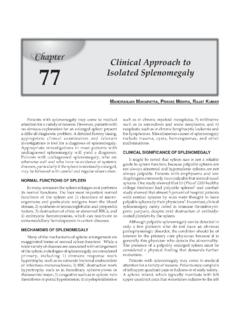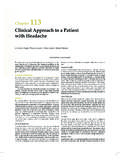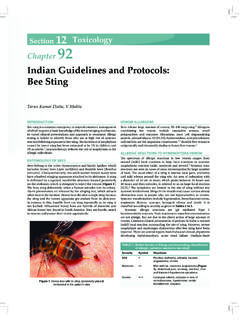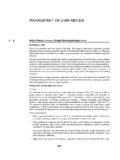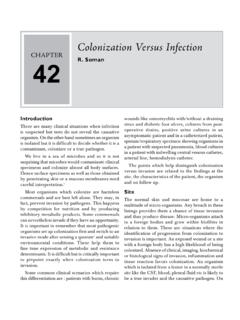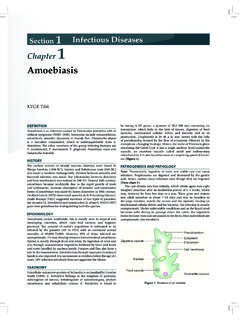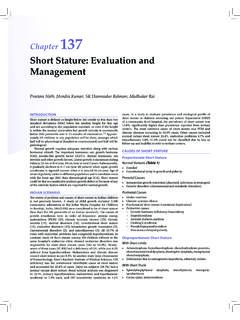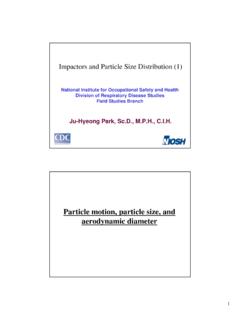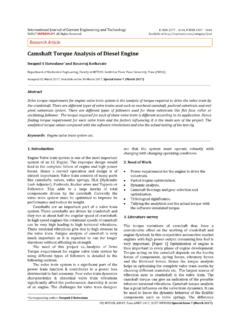Transcription of CLINICAL APPROACH TO DILATED BILE DUCT
1 7 : 4 DILATED bile duct is commonly seen in CLINICAL practice and usually represents an obstructive lesion limiting the flow of bile . The evaluation of DILATED bile duct is aimed to diagnose and treat the obstructive lesion. The CLINICAL APPROACH therefore requires (i) definition of normal limits of bile duct size (ii) predictive markers for obstruction & (iii) imaging modality for defining the level and etiology of obstruction. The following questions need to be answered: Is the bile duct pathologically DILATED ? Are there associated CLINICAL or biochemical features to sug-gest obstruction? Which imaging modality to use for further evaluation? How to treat?The bile duct diameter varies according to the site of measurement. Dilatation may be present in the intra or extrahepatic ducts or both. Distal ductal obstruction causes diffuse dilatation whereas proximal lesions may lead to focal intrahepatic biliary duct (IHBD) dilatation only.
2 IHBD as small as 1-2 mm in diameter are seen as scattered and non-confluent on Computerised Tomography (CT) and ultrasound (US) but become confluent and more easily imaged as they move centrally with diameters exceeding 2mm in size. Abnormal IHBD are present when duct diameter exceeds 40% of diameter of adjacent intrahepatic portal veins and when they appear as parallel tubes coursing together. The upper limit of normal common bile duct (CBD) on ultra sound (US) is 6-8 mm ( lumen) and that of common hepatic duct (CHD) is 6mm. However, on CT scan it is more common to accept a value of 8-10 mm for CBD. This is because CT visualizes mid to distal CBD and the measurement includes the duct wall. On the other hand, ERCP and cholangiogram may reveal a duct diameter up to mm because of magnification of the cholangiogram and may also reflect ductal distension from contrast injection. Measurements may also vary according to the age of the individual. A trend of increasing CBD diameter has been noticed in older individuals.
3 In general, one may add 1mm to the upper limit of normal CBD for each decade of life after 60 years. Dilatation of CBD after Cholecystectomy has also remained a controversial issue. There is a trend of duct dilatation post - cholecystectomy. In a study of 234 patients undergoing cholecystectomy, the CBD increased after surgery from a diameter of mm to at an average 393 days post - cholecystectomy. CBD diameter may increase 1-2 mm post surgery but some patients may have a more profound CLINICAL APPROACH TO DILATED bile DUCTR ajesh Upadhyay, New Delhiasymptomatic dilatation of the ducts. There are also changes in duct size due to other extrinsic factors such as the time of day, respiration or patient positioning. Thus, it is difficult to define an absolute measurement for the duct size which should be interpreted in the CLINICAL context of a potential biliary obstruction and the CLINICAL presentation or biochemical tests may be considered in the decision to pursue further diagnostic evaluation.
4 ETIOLOGY: Identification of the level of biliary obstruction is important in developing a differential diagnosis. Common causes of biliary obstruction include both benign causes choledocholithiasis or neoplastic causes (Table1). The etiology in decreasing order of prevalence is choledocholithiasis, pancreatic cancer, ampullary carcinoma and cholangiocarcinoma. In India, biliary ascariasis is also encountered. EVALUATION: Once a DILATED biliary duct is encountered, the decision to proceed with further evaluation should include both a CLINICAL and biochemical assessment for obstruction ( Fig 1) CLINICAL EVALUATION:The history should elicit symptoms such as jaundice, fever, weight loss, abdominal pain, pale stools, dark urine or pruritus. The physical examination may be limited in utility apart from jaundice. Special attention , however,should be paid to the presence of abdominal tenderness, mass, hepatomegaly or lymphadenopathy.
5 A positive history or physical examination is a clear indication for further diagnostic tests in patient with equivocal duct size on initial imaging. The presence of jaundice, pain or fever has a high probability for ductal stones. BIOCHEMICAL EVALUATION:Liver Function Test (LFT) is essential in patients with DILATED bile ducts. The principal marker of biliary obstruction is serum bilirubin and alkaline phosphates (AP). A conjugated hyperbilirubinaemia Medicine Update 2010 Vol. 20478 Table 1 : Etiology of biliary obstruction according to the siteSITES OF BILIARY OBSTRUCTIONI ntrahepaticPorta hepatisSuprapancre-atic IntrapancreaticPrimary scleros-ing cholangitisSpace occupying hepatic lesionCholangiocarci-nomaPrimary scleros-ing cholangitisGallbladder carcinomaHepatocellular carcinoma Malignant lymph nodesLiver metastases Pancreatic carci-nomaCholedocholi-thiasisCholangioc arci-nomaMetastatic diseaseDirect extension of gastric / colon / gallbladdercarcinomaPancreatitisPancreat ic carci-nomaPancreatitisCholedocholi-thias isAmpullarystenosis /carcinomaDuodenal carci-nomaCholangiocarci-nomaFig.
6 1 : Algorithm for evaluation of Common bile duct Obstruction Common bile duct diameter Ultrasound MRI CT/ ERC Cholangiogram <8 mm >8 mm <10 mm >10 mm No fur ther Evaluation indicated Indeterminate, Obstruction possible, Follow bi ochemistry and imaging Indeterminate, consider patient characteristics such as age or cholecystectomy Further evaluation indicated No fur ther evaluation indicated Indeterminate, obstruction possibl e, Follow bi ochemistry and imaging Indeterminate, consider patient Charact eristics such as age or cholecystectomy Fur ther evaluationindicated Initial Imaging Biochemical / CLINICAL CBD(-) (-) (-) (-) (+) (+) (+) (+) alongwith an elevated AP level is suggestive of biliary obstruction. An AP levels more than three times the upper limit of normal is more specific for biliary obstruction and infiltrative diseases of liver. Transient rise in SGOT / SGPT levels occurs with choledocholithiasis and cholangitis but usually remains less than 500 IU/dl.
7 Mild elevation of transaminases may be present with other causes of obstruction. It is unusual for biliary obstruction and CBD dilatation to occur without CLINICAL or biochemical abnormality. There are instances, however, that choledocholithiasis is present despite normal :This includes US, CT, CT Cholangiography, Magnetic Resonance Imaging (MRI), Magnetic Resonance Cholangio-Pancreatography (MRCP), Endoscopic ultrasound (EUS) & Endoscopic Retrograde Cholangio-Pancreatography (ERCP). Each has advantages and disadvantages as well as limitations in evaluation of the biliary system. The aim of imaging is to define the location, extent and cause of obstruction. Ultrasound is the first line imaging in evaluation of bile CLINICAL APPROACH to DILATED bile Duct479ducts, gall bladder & right upper quadrant. it is usually the initial tests demonstrating dilatation of bile ducts. It is one of the most accurate imaging studies for cholelithiasis with a sensitivity and specificity of 99%.
8 It is also highly sensitive for detecting biliary dilatation with sensitivity of 90%. How-ever, it is less sensitive for defining the level of obstruction (sensitivity 74%) or etiology (sensitivity 57%) or for choled-ocholithiasis (sensitivity 32%). The major advantage of US is that it is inexpensive, non-invasive, and a quick procedure which can be done at bedside. It does, however, require ex-perience in technique and interpretation may be limited due to interference from bowel gas. CT Scan The sensitivity and specificity of CT for diag-nosing DILATED duct is 96% and 91% respectively. It defines the level of obstruction in cases and the cause of obstruction in 70-95% cases. However, it requires IV con-trast with potential adverse effects including nephrotoxicity It also lacks sensitivity for choledocholithiasis(sensitivity 70- 94%) since 20-25% of biliary stones are isoattenuating with bile making them difficult to detect.
9 MRCP has a high accuracy in detecting the level and cause of biliary obstruction (sensitivity 91-97% and specific-ity 99%) for choledocholithiasis and 88% and 95% for ma-lignant disease. Addition of conventional T1 & T2 images to MRCP allows for evaluation of extraductal soft tissue which increases the diagnostic accuracy. The major advantages of MRCP over other imaging techniques includes avoidance of IV contrast, ionizing radiation and ability to visualize the biliary system above and below an obstruction. There are certain drawbacks such as cost, extended time of examina-tion and contraindications such as magnetic objects. Oc-casionally static images showing contraction in distal CBD can simulate stenosis. Endoscopic U/S has emerged as a significant advance-ment in GI endoscopy. It allows both diagnostic evaluation of pancreatio-biliary system as well as therapeutic is highly sensitive for choledocholithiasis (sensitivity >90% and specificity 100%).
10 It is especially useful for microlithiasis (stone < 3mm) and also pancreatic lesions neoplasm and cysts. It has shown greater sensitivity for pancreatic carcinoma (sensitivity 90%) especially for smaller lesions. It provides accurate evaluation of biliary dilatation in > 90% patients. The limitations are poor visualization of proximal CBD lesions and sometimes distal CBD in acute pancre-atitis or in patients with extensive pancreatic calcifications. ERCP With the advent of non invasive MRCP, the role of ERCP has mainly become therapeutic. As a diagnostic mo-dality, it is comparable to MRCP for diagnosis of cause /location of obstruction but MRCP is superior for peri-hilar obstruction because it also displays biliary tree proximal to obstruction and also the character of intra-ductal biliary de-fect. However,ERCP remains the best modality for diagno-sis of ampullary cancers because of direct visualization and ability to biopsy the lesion.
